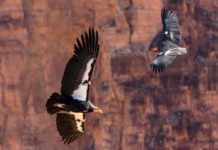
DENVER, Aug. 20 (UPI) — To counteract risky visitor behavior possibly inspired by social media videos, photos and just plain bragging, the U.S. National Park System has released apps and videos to teach hundreds of millions of visitors to stay safe.
An average of six people die every week in the park service’s 419 properties — including 61 national parks — that total 83 million acres. Half of those deaths are from falls, motor vehicle crashes and drownings, statistics show.
In 2017, Rocky Mountain National Park in Colorado, with more than 350 miles of hiking trails and 4.3 million visitors, had 165 serious search-and-rescue incidents and five visitor deaths.
In the past two years, a number of solo hikers, many trying to reach the top of 14,259-foot Longs Peak, died in the park. Three were missing for months and one still has not been found, said Kyle Patterson, a park spokesman.
“We have increased our messaging and are reaching out to the public about Long’s Peak so they understand this is not a hike — this is a climb,” Patterson said.
Three men, ages 20, 38 and 70, disappeared in the park while hiking alone last year. Two bodies were found, but James Pruitt, 70, is still missing.
Social media posts, YouTube videos and selfies might give the impression that it’s easy to make the 15-mile round-trip climb that ascends 5,000 feet. But those images don’t show the planning ahead, altitude acclimation and training that most successful mountain climbers undertake, Patterson said.
Ice and snow can cover the mountain any time of year.
“There is risk if you don’t understand exposure, if you don’t realize you’re going to be scrambling on hands and knees. And fitness doesn’t matter if conditions are horrible. Hypothermia gets everybody, no matter how fit you are or no matter your age,” Patterson said.
Falls are the most common fatalities in Rocky Mountain National Park, followed by medical incidents such as heart attacks, she said.
The park posts up-to-date weather and trail conditions online and extra trail rangers staff some of the most harrowing trails. But ultimately, and especially when hiking alone, a visitor is responsible for his own safety, Patterson said.
This month, Yosemite National Park in California released a new park app to help visitors explore the park, even if they’re out of cellphone range.
In the past 15 years, 290 falling accidents have occurred at the park’s 8,000 ft. Half Dome mountain, including 12 deaths. Until a new permit system was put in place, as many as 1,200 people attempted the climb every day. In 2011, the park instituted a permit system that limited climbers to 300 daily.
A new study published in the journal Wilderness & Environmental Medicine suggests that climbers still are taking risks, some because they feel they have one shot to get to the top of a mountain even if they don’t feel safe, the authors said.
“If anything, the use of permits appears to have increased the individual risk,” the authors said.
Mountain climbing feats such as the 2017 solo climb of 3,000-foot El Capitan granite wall in Yosemite without ropes or safety gear by professional rock climber Alex Honnold can influence amateurs to attempt risky climbs for which they may not be prepared.
About 80 percent of climbing accidents are preventable, Yosemite says in its online messaging.
“In case after case, ignorance, a casual attitude, or some form of distraction proved to be the most dangerous aspects of the sport,” said an accident analysis written by Yosemite Ranger John Dill.
“Climbing in Yosemite has inherent risks and climbers assume complete responsibility for their own safety,” the park’s website says. “Rescue is not a certainty. If you get into difficulties, be prepared to get yourself out of them.”
Park deaths uncommon
With almost 318 million visitors a year, “the National Park System mortality rate is very low” at 0.1 deaths per 100,000 visitors compared to the U.S. death rate of 848 deaths per 100,000 people, said Kathy Kupper, a system spokeswoman.
The National Park Service has seen an increase in search-and-rescue incidents, especially in the mountain West and Southwest regions, with 3,377 reported in 2017. Of those, 990 saves were recorded and 179 incidents resulted in deaths.
Some deaths are caused by accidents out of the visitor’s control. At Montana’s Glacier National Park last week, a 14-year-old Utah girl was killed when boulders from a rock slide struck her family’s car on the popular Going-to-the-Sun Road. Her parents and two other children in the vehicle were injured.
In April and May, five visitors died in Grand Canyon National Park, two from falling off the canyon’s South Rim. In 2017, 70 percent of search-and-rescue incidents in the park were for “slips, trips and falls combined with fatigue or physical condition,” the park website says.
Selfie safety
Snapping Instagram-worthy photos is a tourist pastime in the national parks, but visitors should take care when taking photos, the National Park System says.
The Yellowstone National Park website asks visitors to take the Yellowstone Pledge, including being careful while taking selfies:
- Stay clear of wildlife and snap photos from a safe distance
- Stay on trails and within guardrails
- Don’t try to take photos while driving.
- Stay away from closed areas
“We get it — national parks have some pretty photogenic scenery,” the Yellowstone website says. “The views are truly magnificent. While we want you to capture all of the splendor of our amazing parks, do not put your life at risk for a picture.”





